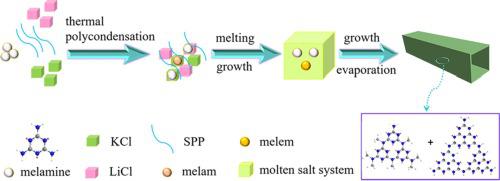Applied Surface Science ( IF 6.3 ) Pub Date : 2021-05-24 , DOI: 10.1016/j.apsusc.2021.150103 Fang He , Meng Wang , Lan Luo , Zhenxing Wang , Shaoqin Peng , Yuexiang Li

|
Hollow SPP-MS-CN nanotubes have been developed through a green one-step approach by sodium polyphosphate (SPP) in-situ mediated molten salt (MS) thermal condensation of melamine for the first time. In which, the structure of SPP-MS-CN with triazine and heptazine units can been directionally modulated by the SPP content. The molten salts at high-temperature function as green solvents to facilitate mass transfer, which tends to form triazine based CN. Addition of SPP mediates the fluidity of molten salt system, which in-situ modulates the thermal condensation process, boosting the formation of the extended π-conjugated system of heptazine based CN. The 0.5 wt% SPP-MS-CN exhibit photocatalytic H2 evolution rate up to 1785 µmol h−1 g−1, which is 2.16 times higher than that of molten salt synthesis of carbon nitride (MS-CN), even 14.5 times enhancement of photocatalytic H2 evolution rate over pure CN obtained by directly thermal condensation of melamine. It reveals that the hollow structures endow SPP-MS-CN with increased specific surface area, and the formed heptazine structure of SPP-MS-CN benefit for charge carrier separation and transfer and H2 reduction ability, which favors for the remarkable photocatalytic activity. Our work opens a new window for in-situ modulation of the structure of CN photocatalysts.
中文翻译:

三嗪和heptazine的定向调制基于氮化碳的高效光催化ħ 2进化
中空 SPP-MS-CN 纳米管是通过多磷酸钠 (SPP) 原位介导的熔盐 (MS) 热缩合三聚氰胺首次通过绿色一步法开发的。其中,具有三嗪和庚嗪单元的SPP-MS-CN的结构可以通过SPP含量进行定向调节。高温下的熔盐起到绿色溶剂的作用,促进传质,这往往会形成三嗪基 CN。SPP的加入介导了熔盐体系的流动性,原位调节了热缩合过程,促进了庚嗪基CN的扩展π共轭体系的形成。0.5 wt% SPP-MS-CN 的光催化 H 2析出速率高达 1785 µmol h -1 g -1其比氮化碳熔融盐合成(MS-CN)的熔融盐合成高2.16倍,甚至比通过三聚氰胺直接热缩合获得的纯CN的光催化H 2放出速率提高14.5倍。结果表明,中空结构赋予SPP-MS-CN增加的比表面积,SPP-MS-CN形成的庚嗪结构有利于电荷载流子的分离和转移以及H 2还原能力,有利于显着的光催化活性。我们的工作为 CN 光催化剂结构的原位调制打开了一扇新窗口。


















































 京公网安备 11010802027423号
京公网安备 11010802027423号